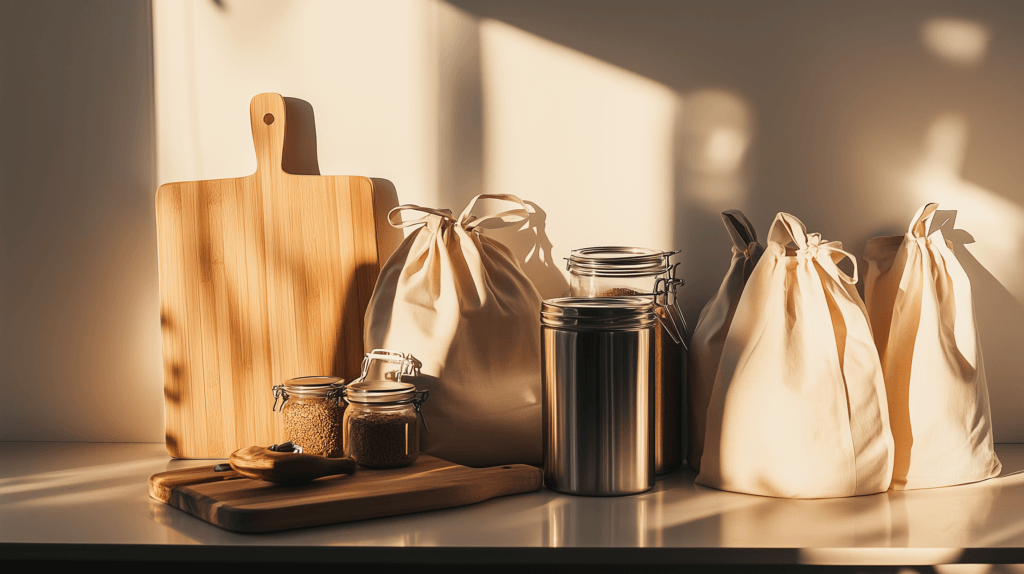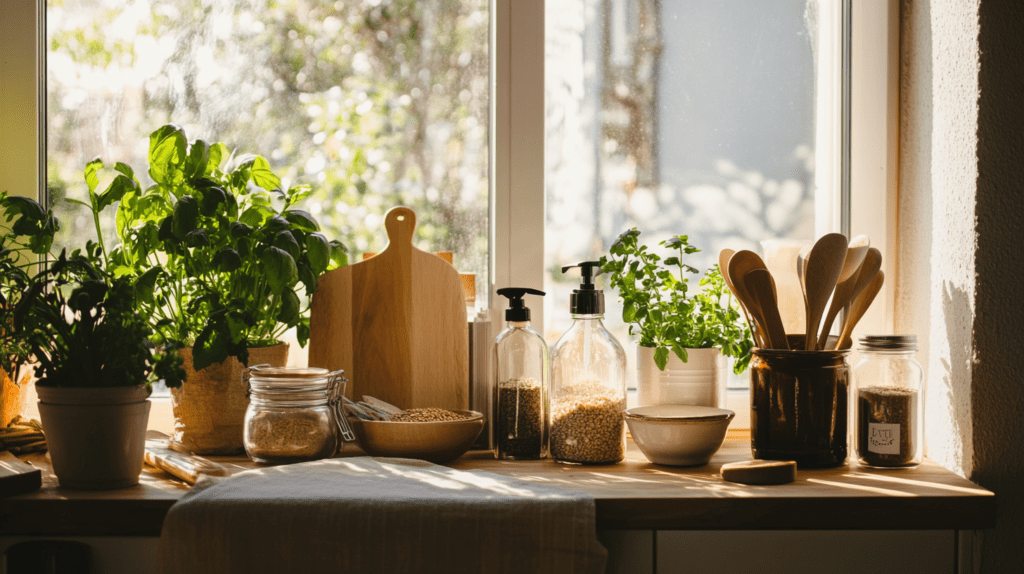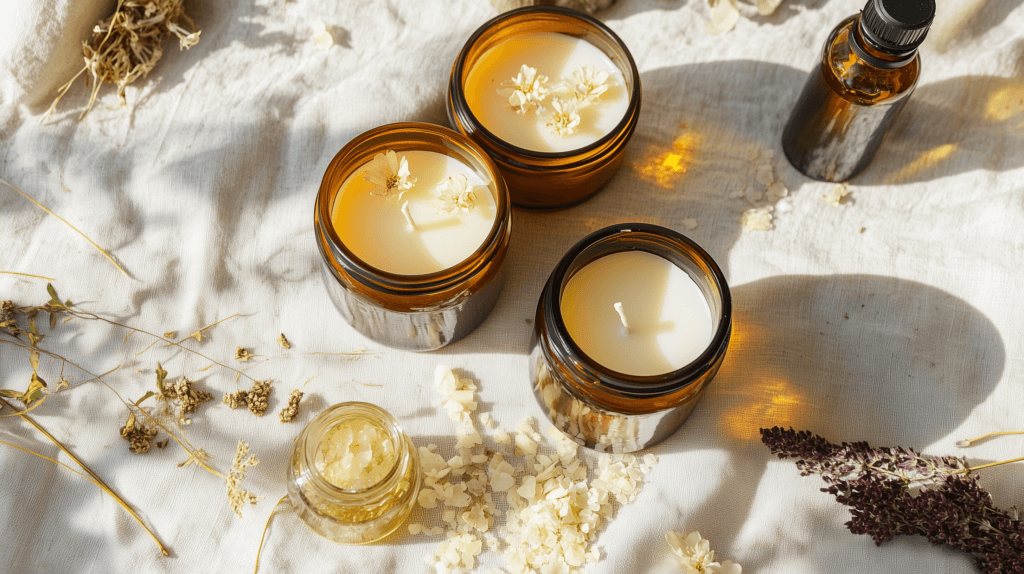This post may contain affiliate links, including those from Amazon Associates. If you make a purchase through these links, I may earn a commission at no additional cost to you. Learn more about our affiliate policy.
When I first started learning about non-toxic living, I was shocked to discover just how many hidden dangers lurked in my kitchen. The very tools and products I used every day to nourish my family—cookware, cleaning supplies, storage containers—were filled with chemicals that could harm our health over time. It felt overwhelming at first, but as I dug deeper, I realized that making simple, intentional changes could create a significant impact on our well-being.
I quickly discovered that these toxins weren’t just confined to the kitchen – many common household products, as I discuss in this guide to creating a non-toxic home, also contribute to a less healthy living environment.
Choosing non-toxic kitchen essentials is about more than just eliminating chemicals; it’s about creating a safer, healthier environment where our food and air are as clean as possible. A toxin-free kitchen doesn’t just protect our health—it also contributes to a more sustainable, eco-friendly lifestyle. It’s a win-win for our families and the planet.
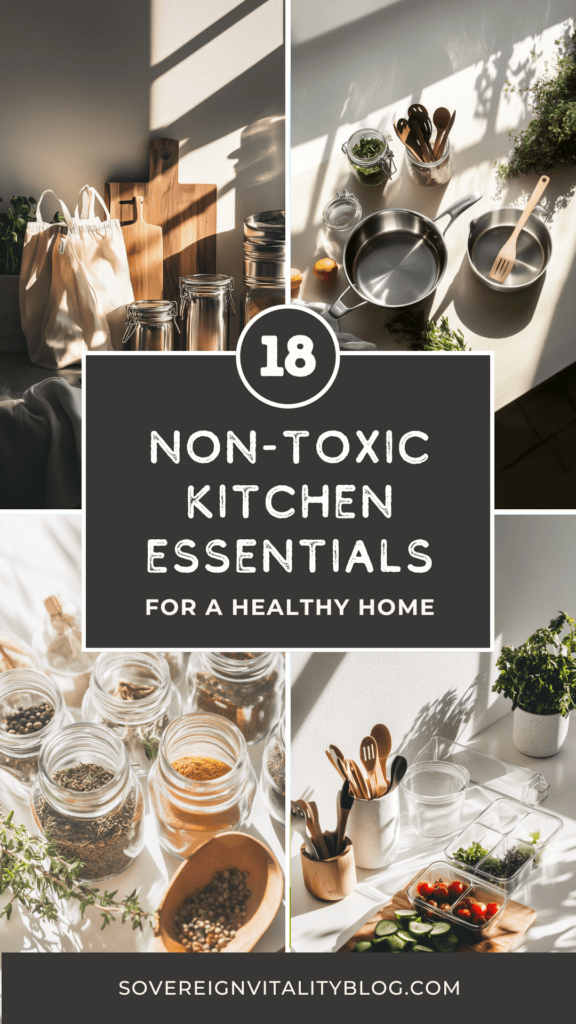
The Hidden Toxins in Everyday Kitchen Products
Did you know that many kitchen products contain harmful toxins? I didn’t, either, until I started paying closer attention. Traditional non-stick cookware, for example, often contains chemicals like PTFE and PFOA, which can release toxic fumes when overheated. Plastic containers and utensils can leach harmful substances like BPA and phthalates into our food, especially when exposed to heat.
Even something as simple as a dish sponge or cleaning spray might be contributing to poor indoor air quality. Many contain volatile organic compounds (VOCs), synthetic fragrances, or dyes that can irritate our skin, lungs, and overall health. Learning about these risks was eye-opening, but it also empowered me to make better choices.
Benefits of Switching to Non-Toxic Alternatives
Making the switch to non-toxic kitchen essentials has been one of the most rewarding changes I’ve made for my family. The benefits go far beyond peace of mind – our home feels fresher, our food tastes better, and I know I’m doing my part to protect the planet.
For instance, swapping out plastic food containers for glass or stainless steel has eliminated that unpleasant “plastic” taste and ensured no chemicals are leaching into our meals. Investing in natural cleaning products means I’m no longer exposing my family to harsh fumes. Plus, these changes often save money in the long run since high-quality, non-toxic items tend to last much longer than their cheaper, chemical-laden counterparts.
Beyond the practical benefits, making these changes feels deeply empowering. It’s a tangible way to take control of our health and align our home with the values of simplicity and sustainability.
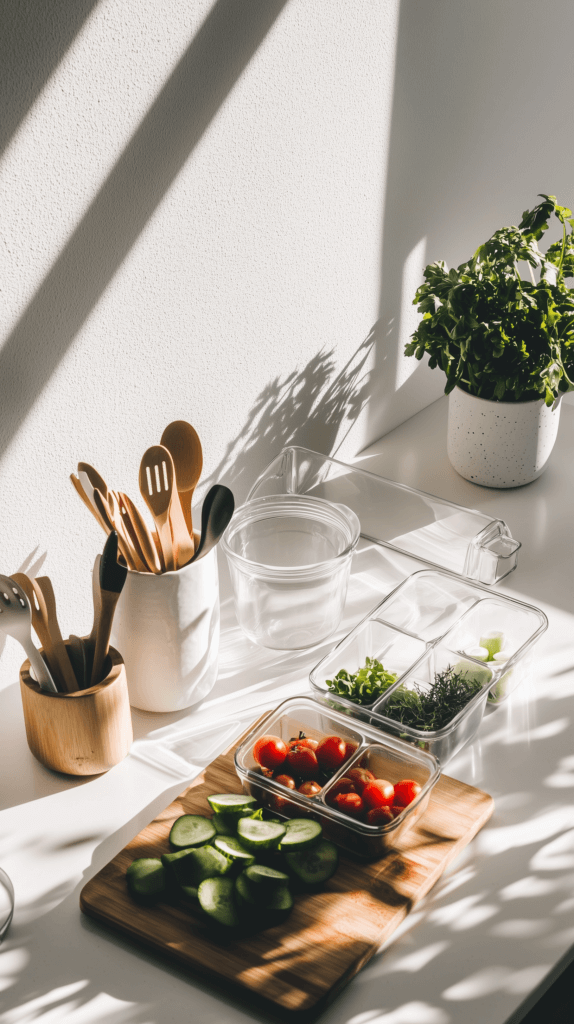
Essential Non-Toxic Kitchen Tools
Making the switch to non-toxic tools doesn’t just make cooking safer; it makes it more enjoyable. These tools are staples in my kitchen, and I’ve carefully chosen them for their safety, durability, and versatility. Here’s why each one deserves a place in your home—and a few trusted recommendations to get you started.
1. Stainless Steel Cookware
Stainless steel is my everyday go-to for cooking. It’s durable, easy to clean, and perfect for everything from sautéing veggies to simmering sauces. I love that it doesn’t leach harmful chemicals, even at high heat. Look for 18/10 stainless steel, which offers the best quality and corrosion resistance.
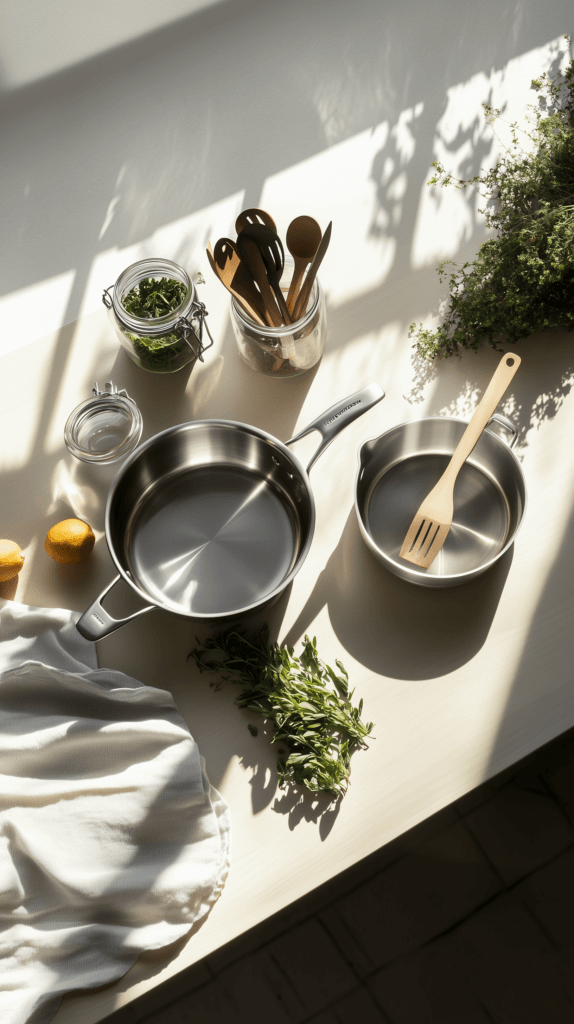
Recommended Products:
- Cuisinart Multiclad Pro Stainless Steel 12-Piece Cookware Set
- All-Clad D3 Stainless Steel Fry Pan with Lid
- Calphalon Classic Stainless Steel Pots and Pans Set
2. Cast Iron and Enameled Cast Iron Cookware
Cast iron has a special place in my heart from growing up in Texas. My grandmother used the set that her mother used, and now I use them daily! When seasoned properly, cast iron is naturally non-stick and can last for generations. For soups, stews, and casseroles, I reach for enameled cast iron, which is low-maintenance and free of seasoning requirements.
Recommended Products:
- Lodge Pre-Seasoned Cast Iron Skillet with Assist Handle
- Lodge Cast Iron Enameled Dutch Oven
- Le Creuset Classic Cast Iron Handle Skillet
3. Ceramic-Coated Cookware
For a safer non-stick option, I’ve switched to ceramic-coated cookware. It’s free from harmful chemicals like PTFE and PFOA, and cooking with it feels effortless. These pans are perfect for quick meals or when I want to ensure easy cleanup.
Recommended Products:
- Caraway Nonstick Ceramic Frying Pan
- GreenPan Valencia Pro Hard Anodized Ceramic Cookware
- Our Place Always Pan
4. Wooden and Bamboo Utensils
Wooden and bamboo tools are staples in my kitchen because they’re safe, sustainable, and gentle on cookware. Whether I’m stirring a pot of soup or chopping veggies, these tools add warmth and natural beauty to my cooking space.
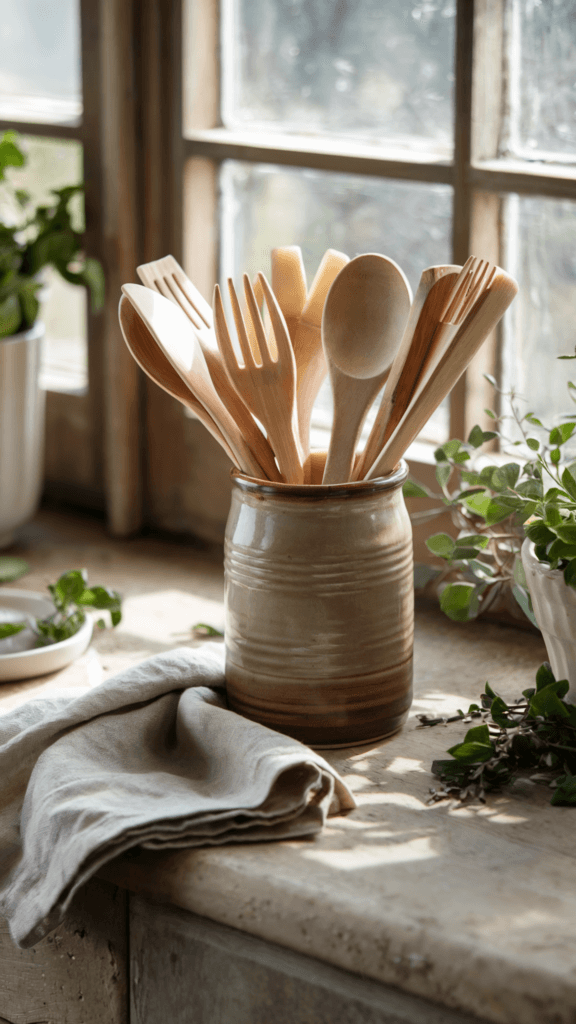
Recommended Products:
Plastic-Free Essentials for a Healthier Kitchen
Eliminating plastic from my kitchen has been one of the most impactful changes I’ve made for our health and the environment. These plastic-free essentials not only reduce exposure to harmful chemicals like BPA and phthalates but also add functionality and style to everyday kitchen tasks. Here’s how I use these items and some of my favorite options to help you get started.
11. Glass Food Storage Containers
Glass food storage containers are a must-have in my kitchen. They’re durable, don’t absorb odors, and are safe for reheating in the microwave or oven. Plus, they look so much cleaner and more organized in the fridge and pantry.
Recommended Products:
- Prep Naturals Glass Meal Prep Containers
- Pyrex Simply Store Glass Food Storage Containers Set
- OXO Good Grips Smart Seal Glass Container Set
12. Stainless Steel Food Storage Containers
When I need something lightweight and durable for on-the-go meals or leftovers, stainless steel containers are my go-to. They’re sturdy, chemical-free, and perfect for everything from packed lunches to pantry storage.
Recommended Products:
- U-Konserve Stainless Steel Food Storage Container
- LunchBots Large Stainless Steel Food Container
- Ecolunchbox Three-in-One Stainless Steel Bento Box
13. Beeswax Wraps
Beeswax wraps are a fantastic alternative to plastic wrap. I use them for everything from covering bowls to wrapping sandwiches and produce. They’re reusable, biodegradable, and keep food fresh without contributing to waste.
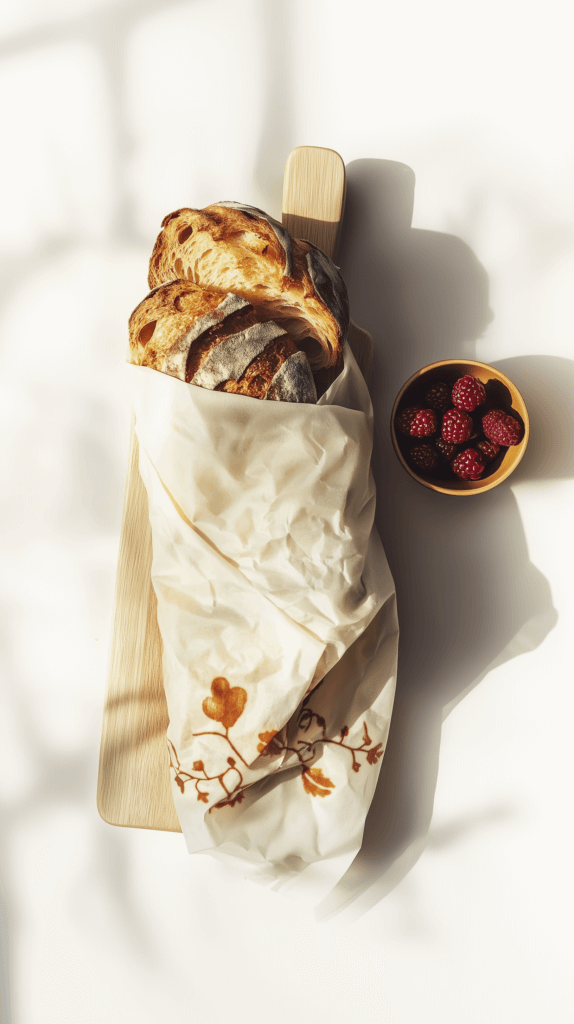
Recommended Products:
14. Stainless Steel Water Bottles and Straws
Stainless steel water bottles and straws are small changes that make a big difference. Not only do they help reduce plastic waste, but they’re also incredibly durable and easy to clean. I always keep a bottle and a few straws handy for drinks at home or on the go.
Recommended Products:
- Hydro Flask Stainless Steel Water Bottle
- Iron Flask Sports Water Bottle
- Hiware Reusable Stainless Steel Straws with Cleaning Brush
Zero-Waste Swaps for a Sustainable Kitchen
Embracing zero-waste practices in the kitchen is one of my favorite ways to align with a more sustainable lifestyle. These simple swaps not only reduce waste but also make your kitchen more functional and eco-friendly. Here are some of my must-haves for a zero-waste kitchen:
15. Bulk Shopping Bags
Shopping in bulk is one of the easiest ways to minimize waste, and reusable bulk shopping bags are essential for making it work. I use them for everything from grains and nuts to fresh produce. Look for lightweight, washable bags that are easy to carry and store.
Recommended Products:
- Lotus Trolley Reusable Grocery Bags
- Earthwise Cotton Bulk Food Bags
- Simple Ecology Organic Cotton Bulk Bags
16. Glass or Stainless Steel Measuring Cups
Plastic measuring cups often warp or degrade over time, but glass and stainless steel options last for years and look beautiful in the kitchen. I use mine for both cooking and baking, and they double as stylish tools for serving or displaying ingredients.
Recommended Products:
- Pyrex Glass Measuring Cup Set
- Hudson Essentials Stainless Steel Measuring Cups
- Bellemain Stainless Steel Measuring Cups Set
17. Wooden Cutting Boards
A sturdy wooden cutting board is a zero-waste staple in my kitchen. Not only are they more durable than plastic alternatives, but they’re also naturally antibacterial and biodegradable. I love the warmth and character they add to my cooking space.
Recommended Products:
18. Refillable Spice Jars
Buying spices in bulk and storing them in refillable jars has saved me so much waste and money. I use glass jars with airtight lids to keep my spices fresh and organized, and they look so pretty displayed on open shelves or in a spice rack.

Recommended Products:
- Aozita Glass Spice Jars with Labels
- Simple Houseware Spice Jars with Shakers
- NETANY 24 Pcs Glass Spice Jars with Bamboo Lids
Tips for Transitioning to a Non-Toxic Kitchen
Transitioning to a non-toxic kitchen doesn’t have to be overwhelming. In fact, the process can be simple and enjoyable if you approach it step by step. Here’s what worked for me when I started making changes in my own home:
Start with One Area
When I first decided to make my kitchen non-toxic, I started small. Rather than trying to overhaul everything at once, I focused on one area. For me, it was my cookware. I swapped out my old non-stick pans for stainless steel and cast iron, which felt like an easy and impactful change. Pick an area of your kitchen that feels manageable—whether it’s cookware, cleaning products, or food storage—and start there. You’ll build momentum as you go.
Gradual Swaps Are Key
One thing I quickly learned was that gradual swaps are far less overwhelming than trying to do everything at once. As I used up a product, I replaced it with a non-toxic alternative. For example, when my dish soap ran out, I switched to a plant-based option. When my plastic containers wore out, I replaced them with glass. This approach not only felt easier on my budget but also gave me time to research and choose the best alternatives for my family.
Prioritize Based on Usage and Budget
Not all swaps carry the same weight, so I prioritized changes that would have the biggest impact on our health and aligned with our budget. For instance, cookware and food storage were at the top of my list because they come into direct contact with our food. I also looked for affordable solutions, like using beeswax wraps instead of plastic wrap, which was an easy way to reduce waste and chemicals. Focus on the items you use most often and go from there.
Conclusion: Transform Your Kitchen, Transform Your Life
Creating a non-toxic kitchen has been one of the most rewarding changes I’ve made for my family. It’s not just about the tools and products we use—it’s about the peace of mind that comes with knowing our kitchen is a safe, healthy space.
By starting small, making gradual swaps, and prioritizing based on your needs, you can create a kitchen that supports your health and aligns with your values. Each step you take, no matter how small, brings you closer to a healthier, more sustainable lifestyle.
Remember, this journey isn’t about perfection. It’s about making intentional choices that reflect your commitment to wellness and sovereignty. A non-toxic kitchen is more than a physical space—it’s a reflection of how much you care for yourself, your family, and the planet.
FAQ: Non-Toxic Kitchen Essentials
1. Why is it important to have a non-toxic kitchen?
A non-toxic kitchen reduces exposure to harmful chemicals found in cookware, storage containers, and cleaning products, improving your health and creating a safer environment for your family.
2. What are the best materials for non-toxic cookware?
Stainless steel, cast iron, enameled cast iron, and ceramic-coated cookware are all excellent non-toxic options that are durable, safe, and versatile.
3. How can I store food without using plastic?
Glass containers, stainless steel food containers, and beeswax wraps are great alternatives to plastic storage. They’re reusable, sustainable, and free from harmful chemicals like BPA.
4. What are some simple swaps to start with?
Start with high-impact changes like replacing non-stick cookware with stainless steel or cast iron, switching to glass food storage containers, and using plant-based dish soap.
5. Where can I buy non-toxic kitchen essentials?
Non-toxic kitchen essentials can be found on Amazon or through sustainable brands like Caraway, Pyrex, and Bee’s Wrap. Many options are also available at local eco-friendly stores.

